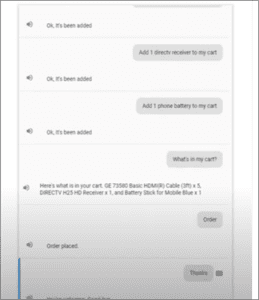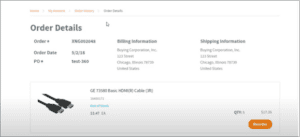
Kathleen Lewarchick
Some digital technologies arrive with fanfare while others enter quietly and become ubiquitous over time. Voice technology is one example of the latter. It gained momentum when developers and users began expanding their views of sound as part of multi-sensory engagement.
Voice activation was popularized by Google. They provided a “speech-to-text option” as part of their search functionality. And voice activation went from a quiet bleeding-edge technology (think OnStar) to a crescendo of widescale adoption as people began to use (and like) Google Assistant, Siri, Alexa, and others.
Making headway in B2B and B2C markets
It was only a matter of time before voice activation would become a powerful tool in commerce. Voice commerce, or v-commerce, is making headway in both B2C and B2B markets. Its technology twin, artificial intelligence (AI), complements and accelerates this trend.
There are obvious benefits, especially for those who are visually impaired or have diminished motor skills. There are also inherent risks, such as authentication and security. However, more and more voice commerce examples are appearing in the B2B market because of ease and simplicity.
One example is hands-free ordering. A facilities manager might be replacing dirty equipment during scheduled maintenance when he or she recognizes a missing piece. One option is to pause work, clean hands and record the part for an order later. The alternative is voice commerce on the job, where the manager pauses for a voice-activated ordering assist, and then quickly gets back to the maintenance job.
Here’s an example of a voice-commerce shopping experience where the buyer:
● Audibly requests items to be placed in a cart, as pictured here:

● Places the order directly through the integrated order management system.
● And receives system confirmation through voice (and visual) outputs, as shown here:

While there’s no guarantee that the part is in inventory, voice commerce enables the order to be placed hands-free at the direct moment of need. Not only does this save time, but it may eliminate order errors if the order process is fully automated.
Essential to B2B business growth
Voice commerce, or v-commerce, is no longer on the horizon. Competitively advantaged companies are using it today to help customers save time and effort. And more users enjoy hands-free technology. It is likely that B2B use cases will only grow given the tight labor market and calls for improved productivity. Getting started on the journey of voice commerce is essential to maintaining your B2B business growth.
Kathleen Leigh Lewarchick is the VP of Marketing for Xngage LLC, a B2B digital commerce services company with more than 60 clients across the industrial trades. She is the former PURELL® Hand Sanitizer Brand Director, has co-created automated replenishment products with Amazon Business, and created telehealth solutions for a company that she later helped sell to CVS Health.
Sign up
Sign up for a complimentary subscription to Digital Commerce 360 B2B News, published 4x/week. It covers technology and business trends in the growing B2B ecommerce industry. Contact Mark Brohan, senior vice president of B2B and Market Research, at [email protected]. Follow him on Twitter @markbrohan. Follow us on LinkedIn and be the first to know when we publish Digital Commerce 360 B2B News content.
Favorite